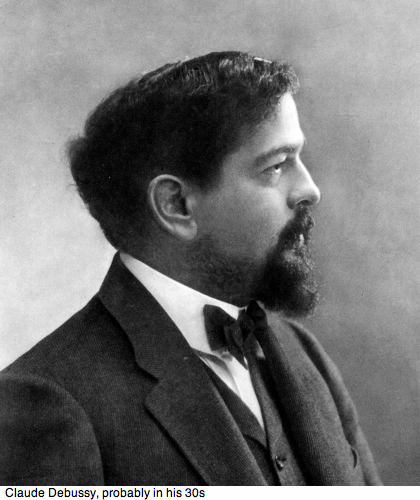
The Eastman School of Music did Claude Debussy and Rochester, New York proud this past weekend with an array of cultural presentations culminating in a multi-media recreation of the life, times and musical excitement that changed the course of classical music history.
It was part of Eastman's celebration of Debussy's 150th anniversary called The Prismatic Debussy, comprising three weekends of performances and a month-long exhibition of manuscripts at the school's Sibley Music Library, the largest academic music library in North America.
Using the resources supplied by Sibley, which holds several invaluable Debussy autographs, artistic director Marie Rolf's entrepreneurial team of internationally renowned musicologists, faculty and deans fueled dazzling demonstrations by Eastman's elite student performers, faculty and alumni. And there are lots still to come through October 27 including Debussy in the comics (thanks to P. Craig Russell) and the North American premiere of five newly discovered songs.
I asked Professor of Musicology Ralph Locke, who played a key role in the design and planning of the celebration, to fill us in.

LV Why does his music matter in 2012?
Ralph Locke Debussy's music is experimental without becoming obscure, passionate but never mawkish, inventively colorful but to an expressive purpose, not merely a decorative one. Composers from Stravinsky and Bartók onward have been inspired by him. He is often described as one of the founding forces of twentieth-century music, and with good reason.

I suspect he was an unusually instinctive artist, yet the songs he wrote at age 19 and 20 -- some of which are only now coming to light -- show that he mastered the craft of composition quite early. He had trouble getting works published in his early years, but the recently published early songs help us see how skilled he was -- and how many different styles he could command -- at an early age.
LV If the center of your listening universe were Debussy instead of Beethoven, who would be the equivalents of Haydn, Handel, Mozart and Bach?
Ralph Locke Debussy drew on a wide range of stylistic and aesthetic models. Painters and poets of the time were immensely important to him. But among composers, I hear César Franck in some of the works, such as Printemps and -- I'm not alone in this! -- the last movement of La mer. He knew the works of earlier composers very well: Palestrina, Bach, Chopin (he published an edition of some of Chopin's works), and -- in many important ways -- Musorgsky. Fauré was an immediate predecessor and contemporary, working almost "in parallel" with Debussy (like Picasso and Matisse). Ravel was another: the relationship between them was deeply fraught. Well-meaning followers pitted them against each other, claiming that one preceded the other in doing this or that. (As if "priority" were all that matters in art!) Debussy was greatly taken with the music to the ballet Namouna, by Edouard Lalo. He got so excited hearing it at a concert that he had to be ushered out of the hall.
The biggest influence was perhaps Wagner. Pelléas et Mélisande is an extremely close successor to the Wagnerian "model" of operatic writing: the orchestra often carries the main musical material, leaving the voices free to declaim Maeterlinck's remarkable poetry-drenched text in natural speech rhythms. Pelléas et Mélisande is also suffused with an almost suffocating sense of hopelessness: there isn't even an overflowing River Rhine at the end to give us the feeling of life beginning anew.
LV What are your favorite Debussy recordings
Ralph Locke I love all different kinds of Debussy performances. The famous Pierre Boulez recordings are luminously clear and precise. The first recording of Pelléas (conducted by Roger Désormière) still has a naturalness about it that has never been surpassed. I'm currently swimming happily around in Natalie Dessay's CD of early Debussy songs, including four that were not published until this past winter. These songs will receive their North American premieres at our Debussy Premieres conference on October 27 (performed by soprano Elizabeth Calleo and pianist Russell Miller). Two other songs will receive their world premiere (by students from the Eastman School and -- via Internet2 -- from the Royal College of Music).
I urge all Debussy lovers to locate a copy of Leonard Bernstein's out-of-print recording of The Martyrdom of Saint Sebastian. Debussy's 1911 work -- using a four-hours-long spoken text by Gabriele D'Annunzio -- has received many remarkable recordings with a single narrator speaking selected lines, but Bernstein uses two narrators instead of one so he can create very theatrical dialogues between the work's two main characters. It helps that the dialogues are declaimed in English using Bernstein's own, very faithful translation.
LV Tell me about the comic book event
.
Ralph Locke Theatrical Debussy is a highly unusual, perhaps unprecedented chance for an audience to encounter a great masterpiece--his opera Pelléas et Mélisande -- from a totally different vantage point. I expect that my comfortable sense of "knowing" this work from recordings, DVDs, and live performances -- and my expectations when I enter the hall -- will be challenged repeatedly over the event's two hours.
Comic Book Debussy is a talk by artist P. Craig Russell about his comic books based on great operas, and Theatrical Debussy is a two-hour presentation of the opera's music in an arrangement for a mixed chamber ensemble plus live electronics, while the panels of P. Craig Russell's comic book--complete with dialogue "balloons" -- are projected on a large screen. I wonder if some members of the audience will be quietly singing along! Well, participatory music making is a hallmark of a thriving musical culture, right?
